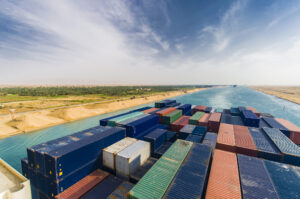
Two shipping disruptions could impact supply and cost of parts
By onInternational | Market Trends
Attacks on cargo ships in the Red Sea and drought in Central America have disrupted shipping through two significant canals. The collision repair industry will likely see an impact on parts delivery and costs for at least several months.
The Iran-backed Houthi group has attacked at least 33 U.S. military, commercial, and merchant vessels since mid-November, according to the Department of Defense (DOD).
“These assaults, notably the unprecedented use of [anti-ship ballistic missiles], have significantly disrupted the free flow of commerce and navigational rights in one of the globe’s most critical waterways,” an official said in a DOD news story.
The U.S. and partner forces have launched defensive strikes against Houthi-controlled parts of Yemen in recent weeks, the story said.
The Panama Canal Authority has reduced daily transits through the canal because of drought in the canal’s watershed, according to the authority’s website. It says this is the first time transits have been restricted.
“As 2023 is the second driest year in recorded history of the Panama Canal Watershed, the Canal has implemented an operational strategy focused on water conservation and transit reliability in the face of low rainfall and the consequent decrease in lake levels,” the website said.
Houthi Attacks
Steve Hughes, HCS International president and CEO, said the Houthi attacks in the Red Sea significantly impact shipping through the Suez Canal. The canal is a major shipping route from Asia to the East Coast.
“This is one of the two major shipping canals in the world,” Hughes said. The other major canal is the Panama Canal.
As delays from the Panama Canal started, many shipping companies began looking at the Suez Canal as its backup option, Hughes said. However, that is no longer an option.
“It has gotten so bad that virtually all of their major carriers have canceled their services going through the Red Sea and they have diverted all of their ships going around the [Cape of Good Hope],” Hughes said.
The Cape of Good Hope routes around Africa and adds a minimum of two weeks to shipping, Hughes said. He said this adds a month for a roundtrip.
“They could have made two trips in the same amount of time,” Hughes said. “It adds significant costs to the carriers in fuel and manpower to keep those ships moving for another two weeks.”
The costs pass to companies shipping goods on the carriers, he said.
If a company doesn’t have large volumes or strong contracts, the shipping company could say there isn’t enough space, Hughes said.
The shipping company could require the goods company to pay a spot contract rate, Hughes said. The spot contract rate fluctuates with the market and has doubled in recent weeks, he said.
Companies that have a slim inventory could start to run out of parts, he said. They could also start raising prices.
During a Collision Industry Electronics Commerce Association (CIECA) webinar Thursday, Ryan Mandell, Mitchell International director of claims performance, said aftermarket products could be impacted most by issues in the Red Sea.
Mandell said the same Asian markets that had delays during the pandemic will be delayed by the Houthi attacks.
Hughes said how long shipping in the Red Sea will be disrupted is unknown.
“Warehouses are going to have to stock heavier,” Hughes said. “They are going to have to plan, if they go westbound from Asia to the east coast.”
Panama Canal
The Panama Canal watershed started seeing drought conditions in October, according to the Panama Canal Authority website.
Currently, 22 vessel transits are allowed through the canal daily, which will drop to 18 starting in February, according to the website.
The canal typically allows about 36-38 transits through daily, Hughes said.
“They are scheduled to cut it to less than half,” He said.
This reduction has caused backup with ships waiting as long as two weeks to get through the canal, he said.
Some shipping companies have started diverting around South America. Others have started running through Los Angeles and then using trucking or rail to get goods to their destinations.
“The spot rates to the West Coast are almost doubled, and they could get worse,” Hughes said. “Supply chain managers are going to have to replan.
“They are going to have to start adding inventory to account for these longer lead times.”
Future Concerns
The U.S. International Longshoremen’s Association has threatened to strike on the East Coast if a labor agreement isn’t reached by in September, Hughes said.
“If the longshoreman go on strike, the ports shut down,” Hughes said. “The East Coast is very, very radical, and I take them at their word.”
The strike could add to current or continued disruptions to the shipping industry, he said.
Hughes said it’s essential to always plan for a possible disruption in shipping. He said there has been at least one disruption to the industry almost every year since 2014.
IMAGES
Photo courtesy donvictorio/iStock
